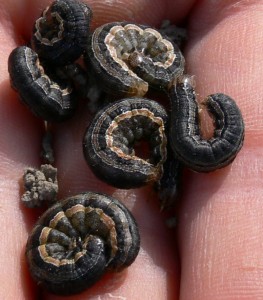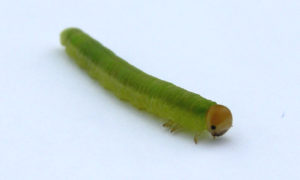Low levels of armyworm, cereal leaf beetles and grass sawflies have been spotted in various wheat fields over the last week. Scout to make sure these don’t get out of hand. With any of these, protecting the flag leaf is most important. Armyworm and grass sawflies clip the wheat head off too.

Armyworm feed at night so scouting at dusk or later is best. They vary in colour but all have a white bordered stripe along their body and a dark band on each of their chubby prolegs. 4 or 5 larvae, per square foot is the threshold, especially if head clipping is occurring. Larvae must be smaller than 1.25 inches for control to be effective. I’d be surprised if we see infestations that reach threshold as back to back armyworm years are rare but I can’t completely rule it out. Control options can be found here.

Both adult and larval stages of cereal leaf beetle can cause damage by chewing long strips of tissue between the leaf veins, leaving the top layer of the leaf intact. This creates a window-paning or “skeletonizing” effect. Most of the injury is caused by the larvae in June. Heavily damaged fields appear silver. The larvae look somewhat like slugs as they are covered in their wet fecal matter to keep from drying out.

CLB adults have black wings with metallic blue or green sheen to them and reddish orange head and legs. One CLB adult or larvae per stem warrants control, especially in the earlier stages of the crop, before heading though some research indicates that early heading stages may also require protection. Control options can be found here.

Grass sawflies were first noticed doing damage in wheat fields in 2011 and occasionally show up again this time of year in random locations. These bright green larvae with dull orange heads feed during the day so they are easier to find in the fields than armyworm. Feeding is usually in small patches in the fields, typically closer to the field’s edge, but not always. They seem to avoid the leaves of the plant and go straight to clipping the plants into 4 or 5 inch sections, leaving piles on them on the ground or clip off the wheat heads themselves. One larvae can clip approx 10 – 12 heads. We tried to run some spray trials in 2011 but feeding stopped quickly after we initiated the trials so I question how much impact these larvae can actually have if feeding is so short-lived. Seeing 30 heads per square meter or 3 per square foot and larvae smaller than 1 inch may be worth the cost of control though no products are registered specifically for this insect. I suggest scouting twice to confirm that feeding continues to get worse, ensuring that the larvae are still actively feeding. And they are tougher to kill than armyworm so a higher rate would be needed.